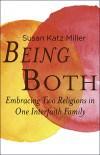
To celebrate the publication of Being Both: Embracing Two Religions in One Interfaith Family, this is the third in a series of portraits drawn from my survey of young people who attended dual-faith education programs in NY, DC, Chicago and California. Since the survey was anonymous in order to encourage honest answers, I use pseudonyms in these portraits (although the book itself is full of real names). However, these portraits are all of real people: they are not composites.
David is an example of a child of interfaith parents, raised with both religions, who ultimately chose Judaism. Raised in Chicago by a Reform Jewish mother and a Roman Catholic father, he had both a bris and a baptism. He writes, “Not knowing what the future held, I am glad that I was welcomed into both religious communities at birth.”
In Chicago, interfaith families raising children with both religions receive extraordinary support from both churches and the Jewish communities there. David started in the Jewish and Catholic religious education program for interfaith children at Chicago’s Family School when he was five years old, and stayed in the program into his teen years. He had a First Communion, a Christian Confirmation, and a Bar Mitzvah. Looking back, David writes, “The coming of age rituals were extremely instructive. It was the preparation and completion of these that guided me to the path I am on today.”
Given the opportunity to create or choose all kinds of complex religious identities for himself when he took the survey at age 20, David chose one word: “Jewish.” Asked how he developed his Jewish identity, David writes that he “chose it for myself” at age 17. He explains further, “The work and personal responsibility involved in Bar Mitzvah proved to be extremely gratifying. It drew me closer to the Jewish traditions than I had ever been, and I cherished it. I also went through a Catholic Confirmation, but upon completion, I knew that it was not for me.”
Theologically, David has made a clear choice. He does not view Jesus as a messiah, although he has great respect for the historical Jesus as a result of his interfaith education. When asked who Jesus is for him, he writes, “A very wise man, or even a prophet, who sent a message of peace in a time of struggle. His message was, and is too often, ignored.”
David reports that he feels comfortable in both churches and synagogues, but having made a choice, he now attends only synagogue. Asked whether he found his education in two religions confusing, he says no, and explains: “It really isn’t all that confusing. It does require some thought, but isn’t that exactly what we should be doing? It is our responsibility to be informed about our decisions. How can we do so without being given all the facts?” And when asked how an interfaith education affects his worldview, David replies, “It has really helped me to be accepting and helped made me so eager to learn about the past and futures of both religions.”
In fact David, like most of interfaith children raised with an interfaith education who took this survey, wants to raise his own children someday with an interfaith education. He sees being an interfaith child as more of an advantage than a disadvantage, and he believes his parents made a good choice in raising him with both religions, in a community that allows children to feel positive about their interfaith status.
In college, David reports that he attends Reform Jewish services, Hillel events or community service every week, is involved in interfaith dialogue, and took a class in Eastern religions. On campus, he writes, his Jewish identity “has grown substantially. There is a great wealth of knowledge to be learned, and such a warm community to get involved with.”
People sometimes challenge David’s right to claim Judaism, because of his interfaith education, but he writes, “I am very proud of my background. If anything, it gave me a wider perspective than is conventionally possible. I am what I am, I chose this path because I believe in it. There is nothing to debate.”

